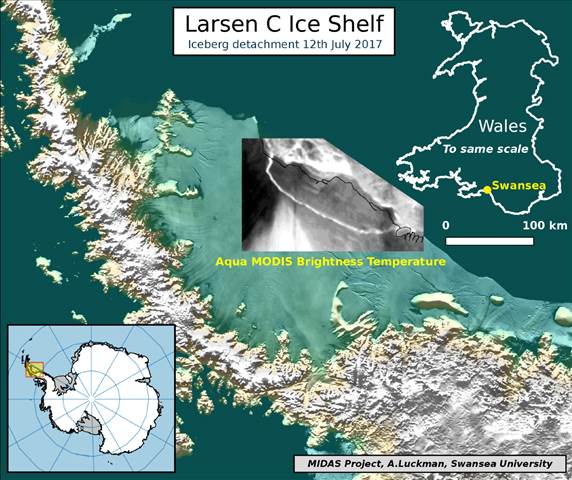One of the largest icebergs ever recorded has broken off from an ice shelf in western Antarctica, researchers said last Wednesday.
The iceberg — about the size of Delaware and weighing an estimated 1.12 trillion tons — finally ripped free sometime between Monday and Wednesday, scientists at the University of Swansea in Britain announced in a blog post.
They also tweeted a map to show where the iceberg detached — a process known as calving — from the Larsen C ice shelf. Scientists began monitoring the slow-moving process in Antarctica’s fourth-largest ice shelf six years ago, tracking the growth of a fissure more than 120 miles long.

They wrote Wednesday that the calving leaves Larsen C — already less than the size of West Virginia — reduced in area by more than 12 percent and the “landscape of the Antarctic Peninsula changed forever.”
The iceberg itself measures more than 2,300 square miles and is on average more than 600 feet thick.
The iceberg is one of the largest recorded and its future progress is difficult to predict,” Adrian Luckman, a professor and lead investigator with Swansea University, said in a statement. “It may remain in one piece but is more likely to break into fragments. Some of the ice may remain in the area for decades, while parts of the iceberg may drift north into warmer waters.”
What happens to the Larsen C ice shelf also remains unknown. Two previous ice shelves known as Larsen A and Larsen B — all named after a Norwegian explorer — have broken up in recent decades. Larsen B, which completely collapsed in 2002, could foreshadow what is now happening to Larsen C.
“In the ensuing months and years, the ice shelf could either gradually regrow, or may suffer further calving events which may eventually lead to collapse — opinions in the scientific community are divided,” Luckman said. “Our models say it will be less stable, but any future collapse remains years or decades away.”
To give a sense of the true dimensions of the Larsen C iceberg, here's an animation based on real data, with something familiar for scale pic.twitter.com/OdQA07qhBb
— Adrian Luckman (@adrian_luckman) July 12, 2017
Researchers said they were not immediately aware the calving is linked to human-induced climate change. Since the ice shelf was already in the ocean and held a relatively small amount of land ice, the potential melting of the freed iceberg is not expected to have an immediate effect on the sea level.
The ice itself, however, could be a risk if it floats into in an area where cruise ships might pass from South America. In 2007, a Canadian cruise ship sunk after it struck ice off Antarctica, forcing the rescue of the 154 passengers and crew on board.
Source: NBC
Women of Green is TURNING UP THE VOLUME of the feminine voice on the planet in order to create the world we know is possible.
